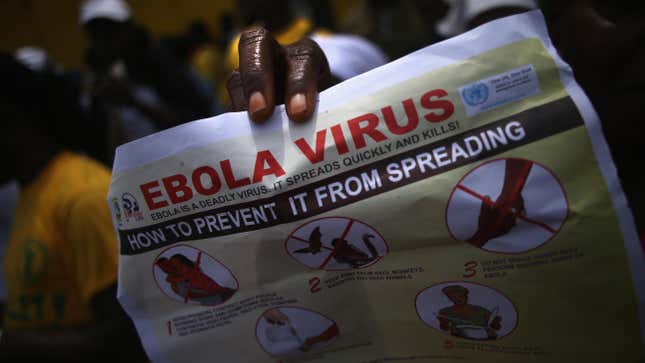
New genetic research appears to confirm a fear scientists had about a deadly outbreak of Ebola in Guinea this February: The source of the outbreak was likely the dormant remnants of the virus in a survivor who caught it at least five years earlier. The discovery could complicate efforts to contain the viral emerging disease.
In late January 2021, a 51-year-old female nurse in the West African country came down with Ebola (formally known as Ebola virus disease, or EVD). Like many victims, she initially experienced vague symptoms like headache, nausea, and general weakness. Though she was hospitalized, her doctors unfortunately misdiagnosed her with malaria and a salmonella infection, and she was sent home after two days. She became sick again at home and died three days later.
Following her death, her husband and other family members who attended her funeral became sick as well, and four would ultimately die. These cases finally alerted national health officials. By mid-February, blood samples confirmed the outbreak, and health care workers rushed to control it. Between February to June 2021, when the outbreak was formally declared over, 16 confirmed cases were reported, along with 12 deaths.
Typically, Ebola outbreaks start with zoonotic transmission from an infected animal to a person, with certain bats thought to be the primary host of the virus. But early analysis of the first blood samples collected from victims during this outbreak suggested something else was going on. The virus seen in their blood looked very similar to a variant collected from survivors of the 2013-2016 West African outbreak of Ebola, the largest and most deadly epidemic of the virus to date, with over 11,000 deaths. Scientists soon suspected the virus had somehow reemerged from a human host years later and was killing again.
This new study, published Wednesday in Nature, all but seals that hunch as being right. Researchers in Guinea, France, and Germany conducted next-generation genetic sequencing of the virus collected from 12 victims of the outbreak, using it to construct complete or near-complete genomes of the virus. They then used this information to build a family tree of the strains and compared them to the virus that was floating around five years ago.
The virus found in Guinea this year was indeed closely related to the virus seen during the earlier West African outbreak, the authors said, indicating “that the new outbreak was not the result of a new spillover event from an animal reservoir.” Moreover, they didn’t find signs of much genetic divergence between then and now, suggesting that it wasn’t being heavily transmitted between humans all that time. Instead, the source virus may have been causing a persistent but slow-moving infection with reduced reproduction in a survivor, or it could have gone completely latent, then reactivated for some unknown reason, making the survivor contagious again.
Scientists have known since the West African outbreak that the virus can survive unnoticed in victims for some time after they’ve fully recovered, especially in pockets of the body where the immune system is less active, such as the eyes or sperm. But the longest known time between someone contracting the virus and passing it on to someone else or becoming sick again, prior to this, was around a year and a half. A much larger window of transmission for the virus means that communities may be more vulnerable to future outbreaks than currently thought. It may also make the lives of survivors, who already tend to experience discrimination and prejudice from others, even harder, the authors warn.
“The human origin of the 2021 EVD outbreak, and the associated shift in our perception of EBOV emergence, call for careful attention to survivors of the disease,” they wrote. “The concern that survivors will be stigmatized as a source of danger should be a matter of scrupulous attention.”
In this case, it’s possible that the unknown patient zero may have transmitted the virus during sexual intercourse. But given that the first new victim was a nurse, the patient may also have experienced a reemergence of symptoms that led to a health care visit and transmission at that point. The nurse herself may have had a dormant infection return, though that’s less likely, since she had no previously documented case.
On the big-picture level, the authors say these findings should fuel research into finding a way to keep survivors virus-free and protecting communities after an outbreak has subsided.
“In addition to the importance of appropriate healthcare measures focused on survivors, the late resurgence of the virus also highlights the urgent need for further research into potent antiviral agents that can eradicate the latent virus reservoir in patients with EVD, and into efficient vaccines that provide long-term protection,” they wrote.